Once black pine seedlings have developed a bit of a trunk, typically after two or three years, it’s time to start wiring. Following Daisaku Nomoto’s advice that young seedlings should develop slowly, I skipped repotting and wired the trees in their current 3″ pots. First I stripped away the lower needles to facilitate wiring, then I removed the topmost soil until I reached the level where roots protruded from the trunk.

3 year-old black pine
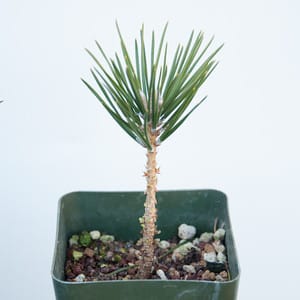
After removing the lower needles to facilitate wiring and finding the surface roots
Nomoto showed me a great trick for anchoring the wire into the pot. I measured a length of wire a bit taller than the seedling and pot and ran the wire through the bottom of the pot. Creating a small hook with pliers and pulling the wire into place secured the wire and made it easy to wire the seedling.
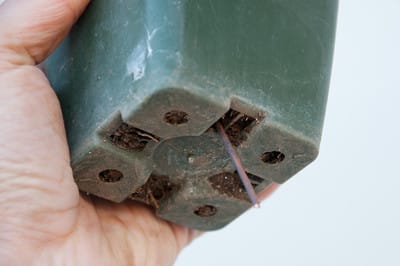
Anchor wire
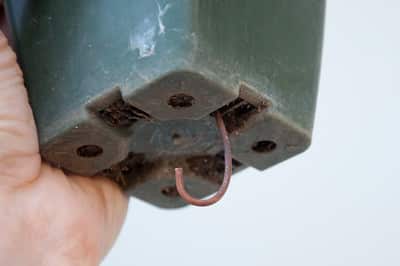
Creating a hook
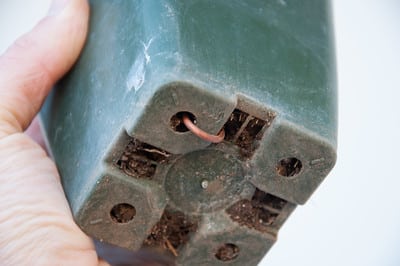
After pulling the hook into place
Nomoto demonstrated the kinds of curves he was looking for at this point. The coils were close together and movement was subtle in all directions – perfectly appropriate for a medium or large sized tree.
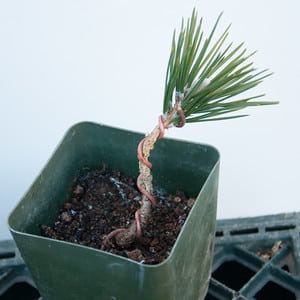
Wired 3 year old seeding
Why does the eventual size of the tree matter? The point at this stage is to develop growth along the future line of the trunk. As smaller trees will have tighter curves than larger trees, we made the curves slight for trees that will eventually grow large and tight for future shohin and kifu bonsai.
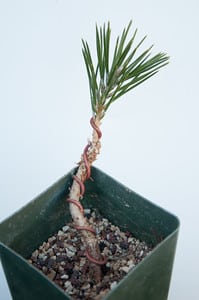
Future large tree
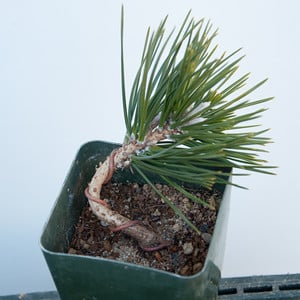
Future small bonsai
Very small curves on a large tree sometimes disappear as the trunk thickens, and in some cases they can cause reverse taper – both undesirable effects. Matching the curves to the future size of the tree is a good check against this.
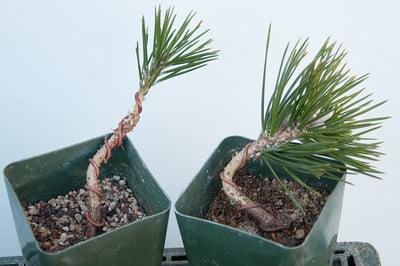
Future large and small pines
Or so I’m told – I’m very curious to see the effect of this approach several years out.
Subscribe to Bonsai Tonight
New Posts Delivered Every Tuesday and Friday
Mac says
Thank you Jonas. I have 6 pines that have been waiting for this.
Chris says
Jonas, why did you guys leave more needles on the ‘small’ tree?
Jonas Dupuich says
Hi Chris – good question. I’m not sure I have a good answer. Different seedlings had different numbers of needles and small branches along the trunk and the few Daisaku worked on ended up with differing numbers of needles. I assumed that we removed whatever made sense for each tree, but it may be that it doesn’t matter much. I’ll see if I can get details next winter.
Chris says
Thanks Jonas. Much appreciated.
Patrick says
Hey Jonas,
Another great post, thanks. I will second the BT article where the japanese grower let the wire bite into the trunk. This thickens the trunk considerably, and the scars grow out. I will add a note of caution though: if your wiring technique is not perfect(some coils are too tight to the trunk etc.) the seedling will bite deeper into the tight coils and not so much in the loose coils. This leads to reverse taper. I have had this happen on a few trees, not sure if it will matter 5 years down the road, bu there you have it. I would love to see a post on how you or your peers approach trunk chopping and branch selection.
Jeremiah Lee says
Jonas, I have learned a ton from your blog. Really appriciate you sharing great info like this.
dirk says
Jonas, what is the reason for developping them slowly at this stage? They need to fatten up and eventually backbud for the first ramification. I’m sure there is a logical explenation why i’m wrong.
Jonas Dupuich says
Hi Dirk – I’d like more clarification on this myself. I don’t know if it has to do with internodes, character of movement or the way bark develops – or anything else. When I asked this of Daisaku he replied that the important thing at this stage was to get the line of the trunk right. Once the trunk was established the tree could then develop at a quicker pace, though still in a container.
One thing I’ve learned from past seedling projects and nursery stock is that bark develops differently when trees grow slowly or vigorously. I’m keen on learning more about this and am hoping I’ll get the chance to do so next year. Thanks for the question!
Dirk says
Jonas, Thanks for the answer, Nice to think deeper over this.
Jon Britt says
Great article!
Chris K. says
Great information! Thank you very much for posting!!
Steve Moore says
Thanks for posting this. Good information!
Robert Dambrauskas says
Thanks Jonas and Adam,
I thought I was the only one crazy enough to grow Black pines from seeds. Looks like there’s hope after all if I’m patient with my one year old seedlings. I am always amazed at the wealth of info from this blog.
Bob
Lilliard says
Great info – thanks for sharing.
Charles Willis says
Great technique! I bet this would be great to use on faster growing deciduous trees like trident maples or Chinese elms.
philip shimko says
this may be a silly question, but what season/cycle is are the pines in for wiring? the candles elongating, before elongatiing, actively growing?” I assume” spring but we all know what that means!
Jonas Dupuich says
Hi Philip – Spring, when the candles are elongating, is of two times not well suited to wiring, the other being after decandling when the summer shoots are developing. Fall and late winter/early spring – before the candles start moving – are good times to wire.